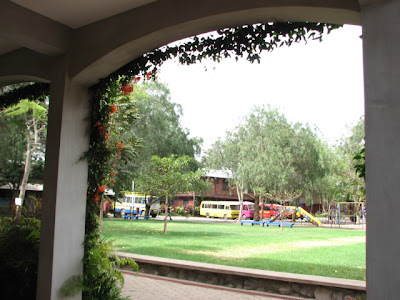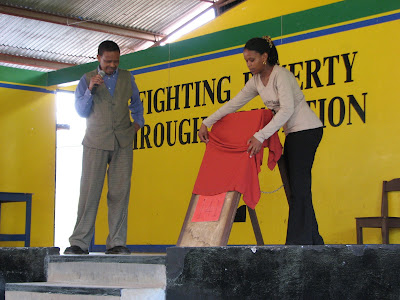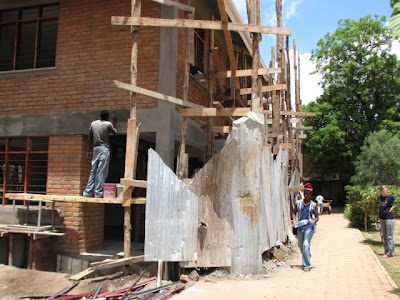The School of St. Jude is an amazing project, in which one woman has greatly improved the lives and prospects of thousands of Tanzanians. (Here's the school's website.) Gemma, an Australian, started the school in 2002. It has expanded to two campuses and boarding facilities for a few hundred students. The school recruits children only from the poorest families, then tests for academic ability and admits those who test well. It's an approach that provides a practically unheard of opportunity for those who would otherwise not have it and will benefit most from it. The school has a reputation as the best in Arusha, and competition is fierce for admittance. Some families lie about being poor, even borrowing a poorer relative's house for screening visits from school officials. But children are admitted at five years of age, so they're not yet clever enough to maintain that kind of lie and will usually admit to watching TV at home, or some similar giveaway. And the admissions officers are very clever and have seen everything by now!
You can see these school buses all around Arusha every morning and afternoon.
The campus is beautiful. It feels like a haven from the outside world.
First stop: the primary school library. A group of children whirled in to return their books fast enough so that...
...they would not miss one word of the new librarian's storytelling.
Things were more sedate over at the secondary school library, where the students were engrossed in the newspaper.
Attendance was down a bit for a few days--maybe parents keeping children home in case of unrest around the elections.
These are baskets of household items the students bring from home to donate to poor families in rural villages. Classes take turns delivering the baskets. Although the students' families are poor, they still experience helping other families and children in need.
The school provides lunch and snacks for the students. This kitchen feeds about 500.
The kitchen staff place tea and rolls outside each classroom for morning tea break (former British colony, eh wot?).
The children gulp down the tea and run for the playground.
A popular toy train that the kids ride in and push. Anna parks her car away from the playground because of fear of being hit by the train.
This group started out with mostly pullers at the front and only two pushers at the back. They weren't moving towards the parking lot all that fast.
...and they got that thing moving!
Signs hang on campus to remind the children to use English while they're at school, and staff correct them if they use Swahili. It's important for them to speak English well for business or for university level education.
Also hanging around campus: signs with the school motto, "Respect, Responsibility, Honesty & Kindness." This one is over the doorway to the art classroom.
Attendance was down a bit for a few days--maybe parents keeping children home in case of unrest around the elections.
These are baskets of household items the students bring from home to donate to poor families in rural villages. Classes take turns delivering the baskets. Although the students' families are poor, they still experience helping other families and children in need.
The school provides lunch and snacks for the students. This kitchen feeds about 500.
The kitchen staff place tea and rolls outside each classroom for morning tea break (former British colony, eh wot?).
The children gulp down the tea and run for the playground.
A popular toy train that the kids ride in and push. Anna parks her car away from the playground because of fear of being hit by the train.
This group started out with mostly pullers at the front and only two pushers at the back. They weren't moving towards the parking lot all that fast.
...and they got that thing moving!
Signs hang on campus to remind the children to use English while they're at school, and staff correct them if they use Swahili. It's important for them to speak English well for business or for university level education.
Also hanging around campus: signs with the school motto, "Respect, Responsibility, Honesty & Kindness." This one is over the doorway to the art classroom.
Art isn't offered in most Tanzanian schools. The teacher is a local artist who has a great talent for teaching. He has an impressive head of dreadlocks, and was wearing overalls made from red plaid Maasai cloth.
The class is so popular with students that many skip their breaks to squeeze in a few more minutes working on their projects. That's a papier mache giraffe in the foreground.
It looks like something exciting must be happening upstairs! I believe the head is part of the papier mache class...
Students remove their shoes when entering classrooms and the library. You have to do that here just to keep things clean because there's so much dust (which will become so much mud in a few weeks).
Here's the auditorium. It has a roof over a concrete floor and open sides. There's a big stage at one end for assemblies. A couple of hours later, it became the cafeteria when benches were stacked and tables moved in.
Anna took to me to see the Friday assembly. Visitors sit up front.
Different classes offered short presentations, which the students in the audience really enjoyed. Where it's important to the cultural content, a presentation can be made in Swahili.
Several students received academic awards, consisting of a certificate and small toys or prizes. I got to hand out some of the prizes up on stage. As they left the stage, a school photographer had each of them sit for a picture.
Braeburn School (the most expensive private school in Arusha) had hosted a football (soccer) tournament the weekend before. The St. Jude teams did really well. One of the secondary school boys' teams placed first, and one of the girls' teams placed second. They received certificates at the assembly.
The students are divided into "houses" and compete for the most points each week. They earn points for good behavior, academic achievement, etc. It's just like Harry Potter, but without the sorting hat. Former British colony and all that. Here, two teachers reveal the weekly scores for each house.
The suspense almost killed the kids! The houses are called Blue, Yellow, Green, and Red. You can tell which house a student is in by the color of the ribbon on their collar.
And Yellow wins!
Gemma didn't plan to operate a boarding school. But parents begged her to provide boarding, because they believe it helps their children learn more effectively. For these children, from Arusha's poorest neighborhoods, the living conditions and supervision at boarding school are healthier, more comfortable, and more conducive to studying than conditions at home. In 2008, Gemma bowed to the pressure and opened a boarding school. Beginning at 10 years of age, students board during the week and return home on weekends. Children younger than 10 do not board.
There are six of these houses, with more under construction.
Eight students share a room with four bunk beds and double decker mosquito nets. These are girls' rooms and they were very neat. Each room had developed their own signature bed-making method. Here, a Maasai cloth in a narrow band across the center of the bed.
The study room. Boarding students are closely supervised and keep a demanding schedule. They have 45 minutes off between classes and dinner, then it's back to supervised study.
Keeping the floors clean.
Bucket collection for laundry and housekeeping. The houses have modern bathrooms with running water and the housekeepers place large jugs of drinking water in the common areas. The school has an elaborate system of tanks for dealing with the common Arusha water outages.
I was inspired by the art teacher to take this shot of the bucket collection as seen through an upstairs window of glass blocks.
Construction is ongoing, both classrooms and boarding houses. The school is expanding to serve even more students.
I bet this is the only construction site in Arusha with female construction workers!
Next stop lunch, back at the auditorium/ cafeteria.
Here's Anna asking the kindergarten class if we can sit at their table.
My lunch partners, Evelyn and Meschach. (Photo by Anna.)
This concludes our tour of the School of St. Jude!
I left right after lunch, because it was testing day, when hopeful parents bring their children for the first round of admittance tests. No visitors are allowed at the school during testing. Competition is so fierce that even a "rich" expatriate can pose a threat, possibly seeing test materials and sharing the information with household employees or neighbors who want their children to attend St. Jude's.
The School of St. Jude is just amazing. I didn't meet Gemma, just saw her from a distance, but I am in awe. Within eight years of working in Tanzania, she's accomplished more than most of us do in a lifetime.
Even though I promised at the start that this post wouldn't be scary, let me just provide a brief update on the national election and my driving adventure in town, as discussed in my last post. (Click here to read about it.) These updates come from a long lunchtime discussion yesterday with my companions from Monday night, my Tanzanian friend Warda, Fernando from Mozambique, and Ezron from Malawi. Actually, I'm thinking of Fernando and Ezron more as bodyguards than mere companions.
On Monday night when we drove through a big rally in town, people were celebrating the announcement of Arusha's election of a candidate from the Chadema party to the national Parliament. Since then, the election commission has announced that the incumbent, President Kikwete of the CCM party, has been elected to a second and final term as President. He was inaugurated yesterday, and all was quiet in Arusha and the rest of Tanzania.
Monday night's rally in Arusha was wild, but didn't turn violent. Fernando and Ezron listened to the BBC news after I dropped them off back at the business training school where they're staying. The BBC said that rallies in two other Tanzanian cities did get violent and police used tear gas.
Warda, who kept placating us three foreigners by insisting the crowd was happy and just celebrating, admitted that she was scared, too, when we were in the worst of it. I wrote that I heard an occasional shout of "mzungu" (white person) from the crowd. Warda told me they were saying that the mzungu must be a CCM supporter because she looked so serious and was not celebrating. Actually, I was neutral on the politics. I looked so serious because I was terrified! That's why Warda started yelling, "Chadema, Chadema," and flipping the "V" victory sign out the window--so the crowd would think we were with them and let us pass.
Fernando said he was "traumatized" by our drive, because it felt too much like 2008 riots in Mozambique. People rioted to protest an increase in food and petrol prices, and the police shot into the crowds. Ezron said he had also seen violent riots in Malawi. They both said that in Africa, you can't tell what will happen. I felt bad then, for roping them into the whole situation. If not for me and Warda, they would have avoided the whole thing by staying at their school, which is in Njiro, near my house, on the quiet outskirts of town. But I also would have been that much more terrified without them in the car driving back to my house, so I'm grateful to them. And maybe I was traumatized, too. Because this afternoon, a quiet Sunday, I could hear a crowd yelling somewhere in my neighborhood. Listening and evaluating, I concluded that it was probably a soccer game. But I still felt shaky and sat glued to my sofa, and canceled my plan to drive to the market for a few items.
But Tanzanians really pride themselves on being a peaceful country. And overall, the election process was peaceful. And, really, are the Chadema supporters any scarier than the Tea Party?
And just to end on a not-scary, not-political note, here's one more picture of cute Tanzanian kids. These girls are not students at St. Jude's, but I met them in the neighborhood near the school.

















































Hi Barbara - found your blog via Lynda over near Kili - I'm guessing you are living in Arusha and I am amazed at the changes in Tz since we lived there in the 80s and 90s - in the South and West, never lived in the North. But Arusha's educational pinnacle in the 90s was the Constantin Greek School - this one you visited seems very swish - and de luxe - is it fee-paying or is there subsidies for the students? I notice you said they are the bright but poor students. It would seem as good as any of the international schools - is it getting international funding? I hope so if it is targeting Tz kids and not just wealthy expats. Are you living/working in Arusha? I lived in Tz for 11 years over 13 years altogether,two kids born there and loved the country. So I am following your blog now - hope you visit and follow mine - I'm back in Ireland now for 13 years but it's been a roller coaster life!
ReplyDeleteAll the best, kwa heri na tutaonana!
Catherine
Karibu, Catherine! The School of St Jude has all Tanzanian students (the expat kids can't pass the poverty screening). Every student is sponsored by donations. Gemma's apparently a genius at fund raising. I'm living in Arusha for the time being, and volunteering as an English teacher at a small tour guide/hotel management college.
ReplyDeletegood and keep it up
ReplyDelete